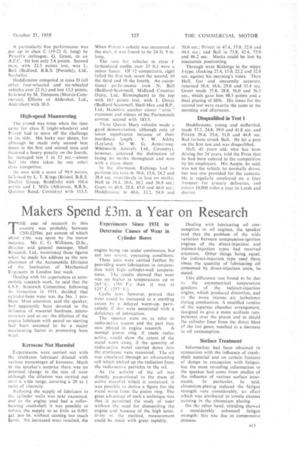Makers Spend Om. a Year on Research
Page 45

If you've noticed an error in this article please click here to report it so we can fix it.
Experiments Since 1931 to Determine Causes of Wear in Cylinder Bores THE cost of research in this country was probably between f2004250m. per annum of which about Om. was spent by the motor industry. Mr. C. G. Williams, D.Sc., director and general manager, Shell Research, Ltd., mentioned these figures when he made his address as the new chairman of the Automobile Division of the Institution of Mechanical Engineers in London last week.
Dealing with his experiences in automobile research work, he said that the LA.E. Research Committee, following its formation in 1931, -decided that cylinder-bore wear was the No. 1 problem. Most attention, said the speaker, had apparently been devoted to the intluence of material hardness, microstructure and so on: the dilution of the engine lubricant with petrol on starting had been assumed to be a major accelerating factor in promoting bore 'wear.
Kerosene Not Harmful Experiments were carried out with the crankcase lubricant diluted with various percentages of kerosene. Much to the speaker's surprise there was no practical change in the rate of wear although the dilution was carried out over a wide range, covering a 20 to 1 ratio of viscosity.
Reducing the supply of lubricant to the cylinder walls was next examined, and as the engine used had a rollerbearing crankshaft it was possible to reduce the supply to as little as 0.001 gal. per hr. without causing too much harm. No increased wear resulted, the engine being run under continuous, but not too severe, operating conditions.
These tests were carried further by providing scant lubrication in conjunction with high cylinder-wall temperatures. The results showed that wear was no higher at temperatures up to 265' C. (500' F.) than it was at 125' C. (257 F.).
Cyclic tests, however, proved that wear could be increased to a startling extent by a delayed warm-Up, particularly if this were associated with a deficiency of lubrication.
The speaker wenton to refer to radio-active tracers and the part they
now played in engine research. A normal piston ring, if made . radioactive, Naould show the extent. of the metal worn away, if the quantity of radio-active metal carried down into the crankcase were measured. The oil was circulated through an oil-counting cell which picked up the radiation from the radio-active particles in the oil.
As the activity of the oil was directly proportional to the mass of active material which it contained, it was possible to derive a figure for the metal worn from the piston ring. The great advantage of such a technique was that it permitted the study of wear without the need for dismantling the engine and, because of the high sensitivity of the method, measurement could be made with great rapidity. Dealing With lubricating oil consumption in oil engines, the speaker said that the problem of the wide variation between compression-ignition engines of the direct-injection and indirect-injection types had received attention. Other things being equal, the indirect-injection type used three times the quantity of lubricating oil consumed by direct-injection units, he stated.
This difference was found to be due to the asymmetrical temperature gradient of the indirect-injection engine, which produced distortion, and tn the more intense air turbulence during combustion. A modified version of the separate chamber arrangement. designed to give a more uniform temperature over the piston 'and to shield the cylinder liner from the direct blast of the hot gases, resulted in a decrease in oil consumption.
Surface Treatment
Information had been obtained in connection with the influence of crankshaft material and on certain features of design in connection with fatigue, but the most revealing information to the speaker had come from studies of the influence of various surface treatments. In particular, he said, chromium-plating reduced the fatigue strength very considerably, an effect which was attributed to tensile stresses existing in the chromium plating.
On the other hand, nitriding showed a considerably enhanced fatigue strength: this was due to compressive stresses.




































































































